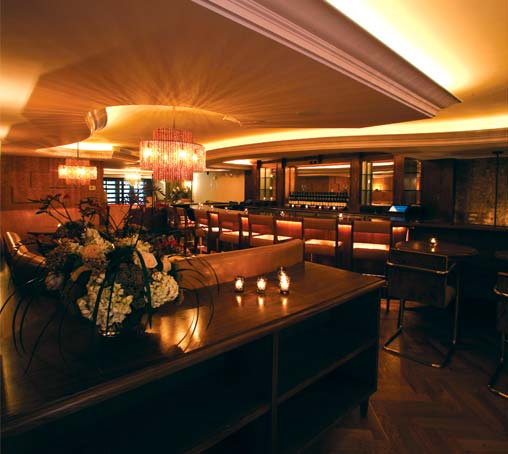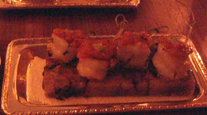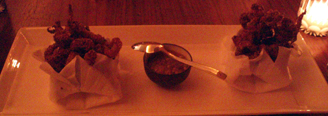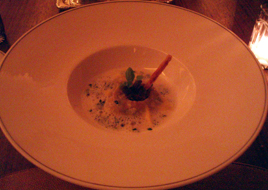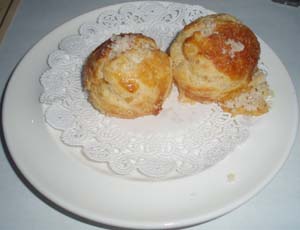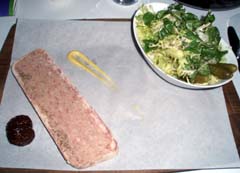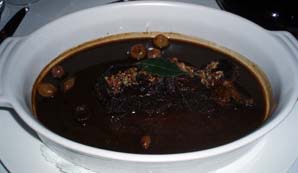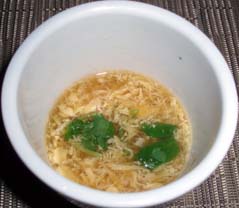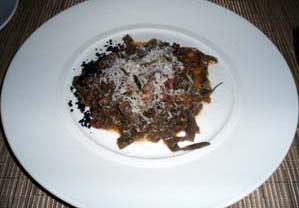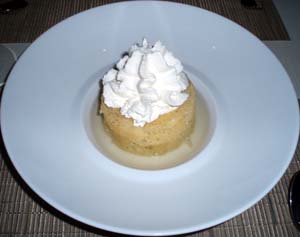
For some restaurants, a favorable New York Times review is make-or-break. Alain Ducasse fired chef de cuisine Christian Delouvrier after Frank Bruni demoted his restaurant from four stars to three, and not long thereafter he closed the restaurant altogether. The owners of Gilt fired Paul Liebrandt after getting two stars from Mr. Bruni, at a restaurant clearly designed for a minimum of three.
Then there is The Modern—another restaurant with three or four-star aspirations that received a mere two. Owner–manager Danny Meyer was none too pleased, but he didn’t panic. Executive chef Gabriel Kreuther is still in place, offering his elegant interpretation of classic Alsatian cuisine. The meal price has gone up since the Bruni review came out. Judging by OpenTable availability and our own experience on Saturday night, the restaurant seems to be full most of the time. Deserved recognition came with a Michelin star, and Frank Bruni’s faint praise didn’t much matter.
Bruni thought that The Modern “will only become better,” but he has continued to take swipes at it, the most recent being an unprecedented three-star review for the Bar Room, The Modern’s casual cousin. I don’t believe there’s any other establishment where the Times has separately rated the casual front-room of a more formal restaurant. And if it had, there is certainly no precedent for giving a “bar room” a higher rating than the main restaurant itself.
 The Modern is located in The Museum of Modern Art, although it has a separate entrance and is open for much longer hours than the museum itself. The main dining room is furnished in austere whites and blacks, with a spectacular view of the Abby Aldrich Rockefeller Sculpture Garden. Fine bone china and sterling silver table settings are paired with elegant and nearly flawless service. The room is lively, but with tables generously spaced, the noise level is not oppressive. However, there is not the hushed solemnity of some haute dining palaces.
The Modern is located in The Museum of Modern Art, although it has a separate entrance and is open for much longer hours than the museum itself. The main dining room is furnished in austere whites and blacks, with a spectacular view of the Abby Aldrich Rockefeller Sculpture Garden. Fine bone china and sterling silver table settings are paired with elegant and nearly flawless service. The room is lively, but with tables generously spaced, the noise level is not oppressive. However, there is not the hushed solemnity of some haute dining palaces.
The menu offers a three-course prix fixe at $85, a seven-course chef’s tasting menu at $125, or a seven-course winter tasting menu at $155. With amuse-bouches and mid-course treats, both seven-course menus are more like eleven courses. The more expensive tasting menu seems to derive its cost mainly from an over-dose of truffles. The chef’s tasting menu, besides being $30 cheaper, actually had more dishes that appealed to us, so we chose that.
Our meal, one of the best we have had in New York, unfolded over more than 3½ hours. Pacing, so often a problem with tasting menus, was impeccable. Even at restaurants that should know better, like Jean Georges and Gordon Ramsay, I’ve had to ask servers to slow down. Not here. When we arrived, we ordered a glass of champagne to start. The staff gave us time to enjoy it, rather than rushing us into ordering. And after we told our server that we had chosen the tasting menu, he asked if we wanted to defer placing the order until after we’d selected wine. I don’t remember that happening at any other restaurant, and we gladly took him up on the offer.
 Paired wines would have been $95 apiece. I’m sure I’ll do a full wine pairing again, but I always feel like I need to be wheeled out on stretcher afterwards, so I asked the sommelier to recommend a single bottle at $100 or less that would go well with the whole meal. He offered two recommendations, at $100 and $105, which seemed a wee bit like gouging. (I like to see sommeliers come within my price limit, rather than trying to exceed it.) I chose the $100 bottle and was quite happy.
Paired wines would have been $95 apiece. I’m sure I’ll do a full wine pairing again, but I always feel like I need to be wheeled out on stretcher afterwards, so I asked the sommelier to recommend a single bottle at $100 or less that would go well with the whole meal. He offered two recommendations, at $100 and $105, which seemed a wee bit like gouging. (I like to see sommeliers come within my price limit, rather than trying to exceed it.) I chose the $100 bottle and was quite happy.
Bread service consisted of baguettes and olive bread, both served warm, with a cube of soft butter on an small two-tiered pedestal. The first amuse bouch was a trio of small bites: a foie gras truffle, a goat cheese linzer tart, and a cucumber ball, accompanied by a glass of roasted fava beans that could easily become addictive.


The second amuse (above, left) was a luscious salmon tartare sandwiched between potato blinis. This brought us to our first savory course, a foie gras terrine (above, right) that was sinfully sweet, thanks to an accompaniment of juniper marinated raisins. The apple compote and duck prosciutto (left side of the photo) were just fine, although arguably surplus for a dish where the terrine took a well deserved bow at center stage.


Next came a perfectly balanced tartare of yellowfin tuna and diver scallops (above, left) on a bed of cucumber, and speckled with Yellowstone River caviar—a breed of which, according to the menu, The Modern purchases the entire annual crop. Maine Lobster (above, right) came with winter vegetables and a spiced broth that was added tableside. This heavenly preparation was more exciting than Per Se’s rendition of a similar dish.


At this point I got caught up in the meal, and for the next two courses, forgot to snap the photos until after we’d started eating them. Chorizo-crusted Chatham Cod in a white coco bean puree (above, left) was another triumph. Long Island Duck Breast coated with a black trumpet marmelade and banyul jus added tableside (above, right) was the evening’s lone disappointment. It seemed too pedestrian after the increasing raptures of the fish courses, and it required too much effort to cut through the duck with the dull knife provided. A pastry called a “Fleischneke,” made from duck confit (top right of photo), sounded promising but was also rather uninteresting.


The cheese cart offered plenty of provocative selections, all expertly explained by the server. I was happy with all of them, but would particularly single out the orange one (third from left), which is actually a bleu cheese with notes of cheddar; and largest of the group (fifth from left), made from three different kinds of milk.


Pre-dessert was a concotion of fresh pineapple, citrus foam and pomegranate, with fresh cilantro that perhaps was a touch too dominant. Dessert was a trio of chocolates—all more than competently prepared, but not as memorable as what had gone before.


The traditional sweets came with a surprise—a miniature raspberry sundae in a cone. (Could it be an hommage to Thomas Keller’s salmon cone?) The tray of petits-fours came on the same style of bi-level pedestal used earlier for the butter, although much larger: it weighed about eight pounds. There was also a box of chocolates (not shown). We concluded with Ethiopian coffee, which was hand pressed and came in its own silver serving pot.
Our meal had a level of sustained excellence, with polished and professional service, that we judged superior to the tasting menu at Jean Georges that we had just over two months ago. If a couple of courses were less that fully inspiring (the duck and the dessert), this was only because everything else established such lofty expectations. During our long meal, we admired the plates coming out to other tables. One cannot judge food by looks alone, but everything we saw was beautifully composed and elegantly presented, with many dishes being finished at tableside.
When we were finished, the staff graciously honored our request for a tour of the kitchen—a gleaming beehive of copper and stainless steel. As we left, we were given a lemon coffee cake; we made fast work of it the next morning.
I’ve continued to read mixed reports about The Modern, which could suggest that it is uneven, or that Chef Kreuther’s brand of fine dining is not to all tastes. I don’t think there is any colorable argument, however, that it is not at least a three-star restaurant. Fortunately, The Modern has been wildly successful without Frank Bruni’s endorsement. But his continuing animus toward this restaurant must nevertheless be reckoned a professional disgrace.
The Modern (9 West 53rd Street between 5th & 6th Avenues, West Midtown)
Cuisine: Modern French/Alsatian, beautifully executed
Service: Pampering and attentive; Danny Meyeresque
Ambiance: A gorgeous modern room overlooking the MoMA sculpture garden
Rating: ★★★★
 Tuesday, October 9, 2007 at 08:35PM
Tuesday, October 9, 2007 at 08:35PM 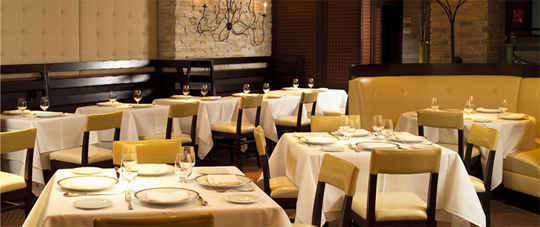
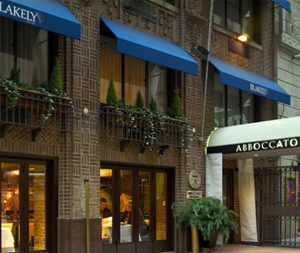 In October 2005, Marian Burros of The New York Times (subbing for the vacationing Bruni) awarded a fairly enthusiastic two stars, finding considerable potential, but a few dishes over or under-salted. In New York, Adam Platt (in the days before he awarded stars) liked the place too, but found the menu overly long and complicated—a problem many Italian restaurants seem to have these days.
In October 2005, Marian Burros of The New York Times (subbing for the vacationing Bruni) awarded a fairly enthusiastic two stars, finding considerable potential, but a few dishes over or under-salted. In New York, Adam Platt (in the days before he awarded stars) liked the place too, but found the menu overly long and complicated—a problem many Italian restaurants seem to have these days.
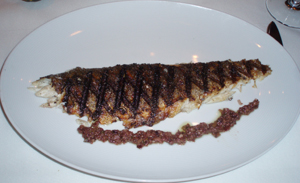
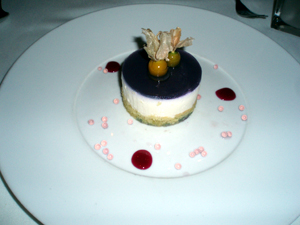 We finished up with the Mascarpone Cheese Cake ($9), topped (improbably) with a strawberry-pink peppercorn sauce that managed to work, despite the odd name.
We finished up with the Mascarpone Cheese Cake ($9), topped (improbably) with a strawberry-pink peppercorn sauce that managed to work, despite the odd name.

